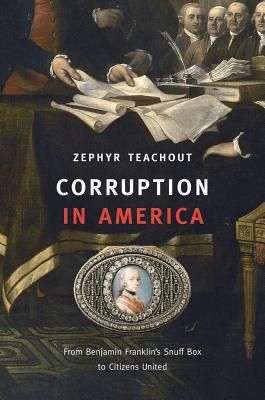Corruption in America: From Benjamin Franklin's Snuff Box to Citizens United
Zephyr Teachout

Zephyr Teachout is an awesome person, and this is an awesome book. If you happen to live in New York’s 19th congressional district (Dutchess County), you can vote for her for Congress this fall!
She is also a law professor at Fordham University, and this book shows the overlap between her legal studies and her political convictions. At a high level, the book is a critique of the Citizens' United supreme court decision. In service of that critique, as the title suggests, ZT provides an overview of American corruption law from the 1700s to the present. This history is written to be accessible to a non-specialist reader (although while reading it, I felt that I had some inkling of the grind of law school!).
To vastly oversimplify her argument, she draws a distinction between “prophylactic” corruption law, which uses ex ante blanket prohibitions on certain activities that are viewed as conducive to corruption, and a second type (I can’t remember if she has a specific term for it, but I’d call it something like “transactional”) that focuses more on identifying and punishing ex post specific corrupt acts, with “corrupt” being narrowly defined as an explicit quid pro quo. The American founders were fairly radically focused on prophylactic rules, largely in reaction to what they saw as a corrupt European political culture. This tradition carried well into the twentieth century. During this phase of jurisprudence, lobbying was seen as prima facie corrupt, similar to the act of selling your vote. (This is an interesting analogy that she raises; similar to voting, every citizen has a right to represent his or her interests in front of elected officials, but cannot sell that activity and represent the interests of another.) Over the late twentieth century, the trend of jurisprudence changed somewhat abruptly. She largely traces the change to Buckley v. Valeo, a 1976 case that struck down campaign finance limits as unconstitutional. Since then, prophylactic laws have generally been struck down as unjustified restrictions on free speech, and the court has focused on whether any specific quid pro quo can be proven. Of course, this means that effectively corruption law is dead, because anyone with half a brain can get a deal done without leaving any specific evidence of quid pro quo–and furthermore, influence peddling encompasses a lot more than QPQ. ZT gives some thoughts on why recent cases departed so abruptly from tradition, although you get the sense that she is as puzzled by it as anyone else. Two key items she points to are the rise of “law and economics” scholarship, which encourages a focus on identifiable transactions, and the shift in composition of the court towards academics and career judges (where previously, for example, many former elected officials served as justices)–people who may not have as good of a feel for how influence trading actually works in a legislative body.
Bernie Sanders is supporting Teachout’s run for Congress, and it’s easy to see why. The issue of Clinton’s unreleased Goldman Sachs speeches (and associated paydays), for example, is right in the wheelhouse of the understanding of corruption put forward in this book. During the Democratic debates, Clinton would defend herself by saying, “Show me one instance when I changed my vote on financial regulation because of a donation!” This line of argument more or less exactly echoes the very narrow view of corruption that Teachout describes as taking hold in the latter twentieth century, and is totally divorced from the broader and, I think Teachout argues convincingly, the more appropriate conception upheld throughout most of American history.